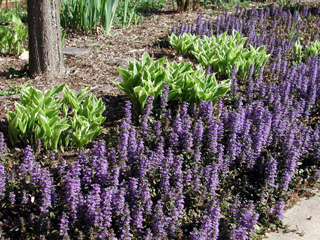Resource Library
Plant of the Week: Ajuga, Bugleweed
Plant of the Week
Ajuga, Bugleweed
Latin: Ajuga reptans
 Ajuga is one of those old standby groundcovers that settle into the background and
are easy to forget. (Image courtesy Gerald Klingaman)
Ajuga is one of those old standby groundcovers that settle into the background and
are easy to forget. (Image courtesy Gerald Klingaman)
Like most gardens, mine has several items I never planted. One of these is ajuga or bugleweed (Ajuga reptans), the creeping herbaceous perennial that can be found throughout most of the Eastern states. It is just here, there, everywhere but is easy to overlook as we go about our lives.
Ajuga is one of about 45 species belonging to the mint family that are widely distributed in Europe, across Southwest Asia, Northern Africa and as far south as Australia. Ajuga reptans, the only species widely grown in this country, is native to Europe and the Near East and North Africa but has been in cultivation so long it is found throughout the temperate world.
It is a creeping herbaceous evergreen groundcover that grows as a series of ground-hugging rosettes with spatula shaped leaves. In the typical form the leaves are green but in gardens the purple-brownish leafed form ‘Atropurpurea’ is most often grown. However, white-variegated (‘Silver Beauty’, ‘Variegata’), pink-variegated (‘Burgundy Glow’) and tricolored (‘Multicolor’) selections are available and widely offered. Leaves are typically 3 inches long and an inch wide but narrow, strap-shaped leafed forms (‘Valfredda’ aka “Chocolate Chip” and the variegated ‘Dixie Chip’) and big, beefy, bronze-leafed forms (‘Catlin’s Giant’) are also available. About 40 cultivars of this species are offered.
Ajuga spreads by means of a series of horizontal stolons that radiate in all directions from the central crown, making them quick to cover bare ground and potentially invasive in the garden. Stolon formation seems to be a long day response and is limited to the summer months. Plants colonize bare ground quickly and can crowd other groundcovers or creep into lawns and walkways.
Ajuga is mid-spring blooming, producing erect, 8-inch tall trusses of blue, tubular two-lipped flowers. Pink and white forms are available but less commonly seen and seemingly somewhat less vigorous. The flowers are very effective in the spring garden but ajuga’s use as a groundcover is its primary role in gardens.
Ajuga seems to be like the quiet student in the back of the classroom - always there and taking it all in but without being noticed. The Latin name was chosen by Linnaeus, probably from an old classic name for the plant, but there seems little agreement as to what it means. Bugle and bugleweed are two old English names used to describe the plant but the derivation of that name is likewise obscure.
The plant was used medicinally for staunching blood flow and to make a tea for coughs, but even that was just background noise with heal-all and other members of the mint family taking center stage for medicinal purposes.
There is no record of when ajuga was introduced into the United States but it was probably at an early date. Ajuga is widely naturalized but does not seem to escape into the wild, instead escaping into unwanted areas in lawns and gardens. While seeds are produced, most spread seems to be by the expansion of the colony.
Ajuga is an excellent groundcover for use in discreet patches along walkways and in partially shady nooks in the garden. It is hardy from zone 3 through 9. But in the South I do not recommend it as a widely planted groundcover over an extensive area because it is plagued by crown rot – a symptomology that can be caused by any of the four most common and destructive soil borne diseases. These fungi are most severe in heavy, poorly drained clay soils. Exposure to full sun conditions in late afternoon exacerbates the situation. While large expanses of ajuga groundcover usually begin to melt away after a few years, it is a tough survivor that will freely spread if the right combination of soil and light exposure are found.
By: Gerald Klingaman, retired
Retired Extension Horticulturist - Ornamentals
Extension News - June 27, 2014
The University of Arkansas System Division of Agriculture does not maintain lists of retail outlets where these plants can be purchased. Please check your local nursery or other retail outlets to ask about the availability of these plants for your growing area.